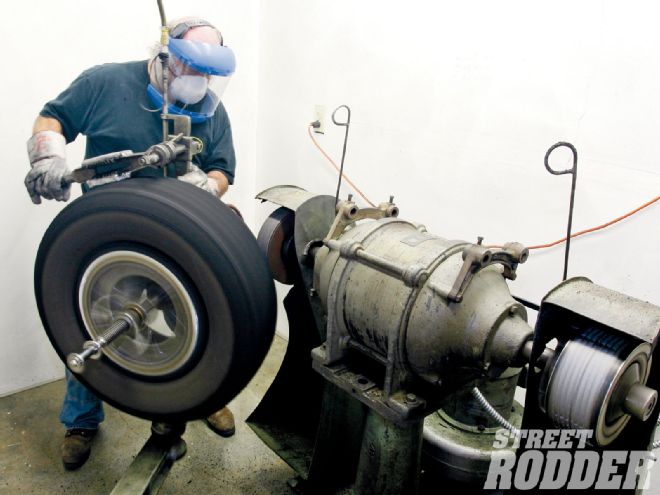
Whoever said you can't have your cake and eat it too doesn't know Hurst Racing Tires. For years Hurst has been doing something that seems to defy the laws of nature: building tires that look like traditional bias-plies yet act like modern radials.
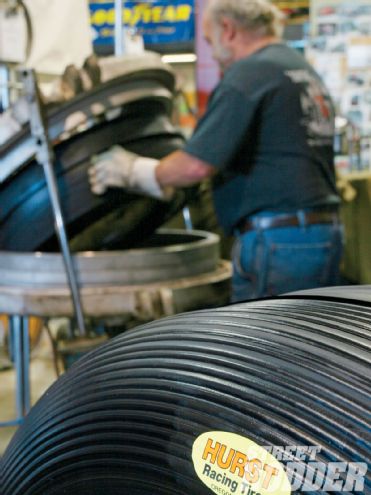
That's cause to take notice, if you didn't know. For years hot rod enthusiasts have faced a conundrum: bias-ply or radial? Without getting too technical, bias-ply construction makes a very stiff sidewall and soft tread that rides harsh and feels unstable on uneven surfaces. But that construction also lends itself to a real neat-looking, square-edge tread.
Radial construction, on the other hand, makes a compliant sidewall and stiff tread that rides and tracks better over very uneven surfaces. Unfortunately, their fatter sidewalls and rounded edges make most radials look like taxicab tires.
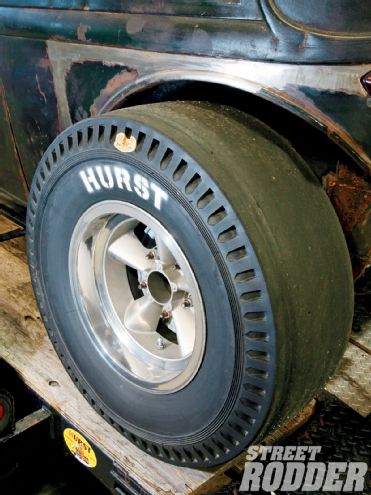 Nothing says '50s or '60s competition tire like a pie-crust sidewall and nothing makes it quite like the tooling that originally made it popular. But the vintage personality runs only skin deep, for below that tread is a good-riding, good-handling, modern radial tire.
Nothing says '50s or '60s competition tire like a pie-crust sidewall and nothing makes it quite like the tooling that originally made it popular. But the vintage personality runs only skin deep, for below that tread is a good-riding, good-handling, modern radial tire.
The problem is that, like engines and wheels, tires are focal points on hot rods. And since the hot rod movement gained steam during a period where bias-ply tires were the only option, many consider them the appropriate choice for a car that represents the era. So for years the choice for history buffs was this: grumble at the way the car rode and handled on rags or wince at the way it looked on radials.
But that needn't be the case. Once stripped of their treads-hides if you will-tires look remarkably similar; it's really only the non-structural rubber applied to a casing that makes a tire look a certain way. Knowing this, Hurst Racing Tires' founder Ron Hurst took a tread intended for a bias tire and applied it to a radial casing ... and it stuck, so to speak. From that point he used radial casings when he recapped tires.
OK, we know what some of you are thinking right now. A number of you still blame tire recapping for those strips of wayward rubber on the highway. If you don't know what we're talking about, here's the score: For decades there's been this misconception that a recapped tire will do like a snake and spontaneously shed its skin.
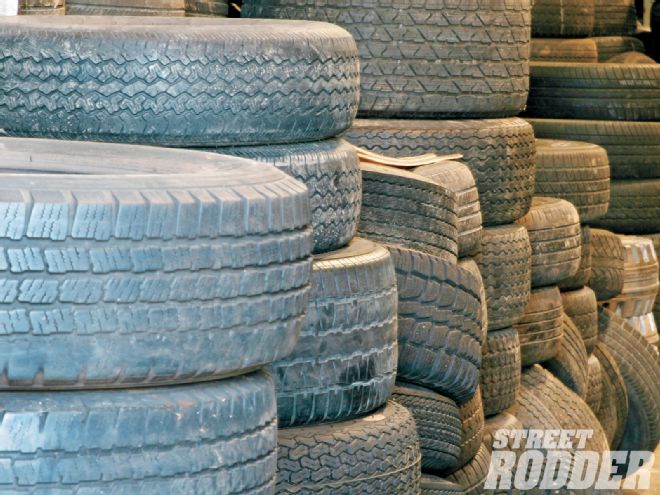 Casing dimensions narrow the available tire core pool considerably and a rigorous inspection process narrows it further. Hoarding is one thing, but Hurst often buys new tires to maintain inventory or create its specialty designs.
Casing dimensions narrow the available tire core pool considerably and a rigorous inspection process narrows it further. Hoarding is one thing, but Hurst often buys new tires to maintain inventory or create its specialty designs.
While a recap can separate, according to several studies, including one conducted by the University of Michigan for the National Highway Traffic Safety Administration (NHTSA) and another by the State of Virginia, new and properly recapped tires have about the same failure rate. As it turns out, abuse and neglect are the leading causes of tire failure. And when a tire fails, it's the belts that separate and not the final layer of rubber. "Whenever you see a rubber strip in the road, take a close look at it," Hurst Racing Tire's Steve Adams instructs. "If you see steel, that means the casing failed. We don't touch the casing; we only apply new rubber to it."
Like an engine rebuild, the recapping operation is truly a remanufacturing process; just as a machinist replicates the last operations in a part's production, a recapper replicates the last stages of a tire's construction. After verifying the tire's integrity, a recapper strips the old tread and applies uncured rubber to the prepped casing. Baking the dressed tire in a mold-or matrix to use the correct term-forces the various rubber elements to merge seamlessly to form a single, solid composition. In that sense recapping is like welding but it's also like casting: the mold cures the rubber in its shape.
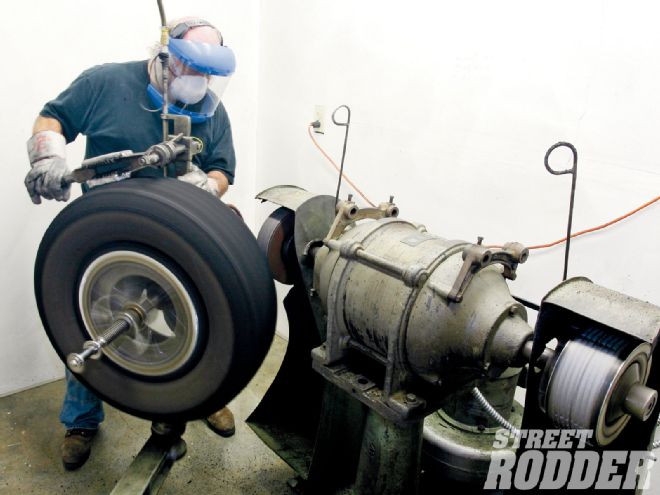 Once Steve or Cody Adams deem a tire worthy, they use a very aggressive toothed wheel on a giant motor to remove or buff the tread. They stop just short of the tire's structure, which takes considerable skill.
Once Steve or Cody Adams deem a tire worthy, they use a very aggressive toothed wheel on a giant motor to remove or buff the tread. They stop just short of the tire's structure, which takes considerable skill.
Like casting and welding, proper recapping relies heavily on technology and experience. Since he founded it in 1961, Ron Hurst constantly invested in newer and better tooling. By the time he sold the company to Steve Adams in 2005, Hurst Racing Tires had a reputation for building high-quality competition tires. Steve, in turn, brought considerable experience and even newer methods to bear on the process: from 1977-94 he recapped tires for a vendor who serviced commercial truck lines and international shippers.
Hurst relies on several generations of tooling to create its tires. They look the part of a '50s or '60s competition tire because Hurst still uses the same matrixes that made that style popular half a century ago. What you can't see are the tools that improve a tire's consistency, durability, and overall quality.
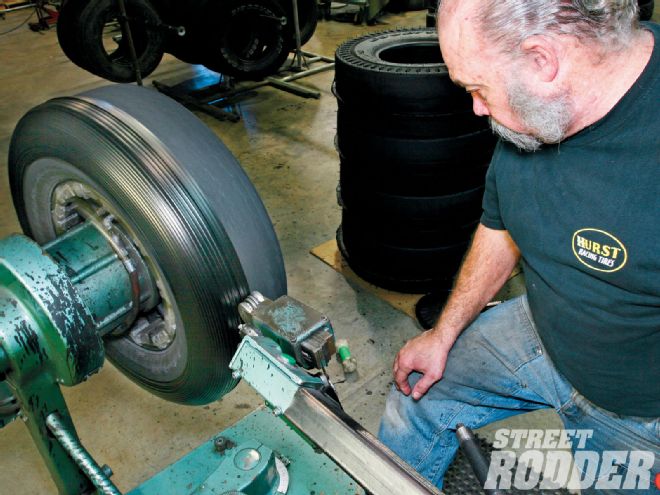 The Orbitread then applies the extruded rubber to the tire as one consistent "rope" or strip. Prior to this method, recappers wrapped casings with tongue-like strips of rubber, a wasteful process that required equal parts of luck and skill.
The Orbitread then applies the extruded rubber to the tire as one consistent "rope" or strip. Prior to this method, recappers wrapped casings with tongue-like strips of rubber, a wasteful process that required equal parts of luck and skill.
In fact, you really can't tell the tires are recaps; Steve and his son, Cody, take great pride in their ability to conceal the place where the old rubber meets new. As an endorsement to this quality, consider that two cars that competed for America's Most Beautiful Roadster title at this year's Grand National Roadster Show wore their tires.
It may sound boring but we're here to tell you that the process Hurst uses to build old-looking, new-acting tires is one of the most intriguing things you can experience. So when Steve and Cody invited us to see it happen, we burned, well ... you know.